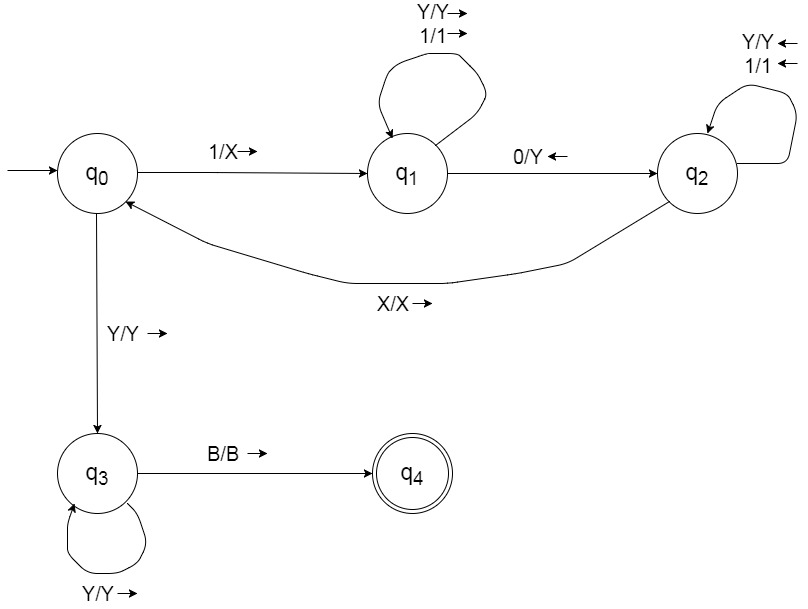Program for Turing Machine capable of recognizing the language 1^n0^n where n>0
Formal definition of Turing Machine (TM)
A Turing machine is a 7-tuple, (Q, Σ, Γ, δ, q0, qaccept, qreject), where
Q, Σ, Γ are all finite sets and
1. Q is the set of states,
2. Σ is the input alphabet not containing the blank symbol B,
3. Γ is the tape alphabet, where B ∈ Γ and Σ ⊆ Γ,
4. δ: Q × Γ→Q × Γ × {L, R} is the transition function,
5. q0 ∈ Q is the start state,
6. qaccept ∈ Q is the accept state, and
7. qreject ∈ Q is the reject state, where qreject != qaccept.
State Diagram
Here,
- Q= {q0, q1, q2, q3, q4}
- Σ= {0, 1}
- Γ= {0, 1, X, Y, B}
- qs= q0
- qaccept = {q4}
- qreject = { Ø }
- δ is given by the following transition table
Transition Table:
Program
#include<stdio.h>
#define BlankSpace
'\0'
int main()
{
char inpstr[50];
int head, state;
printf("Enter String: ");
scanf("%s",inpstr);
state=0;
head=0;
printf("\n");
printf("%s ", inpstr);
while(1)
{
if(state==0)
{
if(inpstr[head]=='1')
{
state=1;
inpstr[head++]='X';
}
else if(inpstr[head]=='Y')
{
state=3;
inpstr[head++]='Y';
}
else
{
state=5;
break;
}
}
else if(state==1)
{
if(inpstr[head]=='1')
{
state=1;
inpstr[head++]='1';
}
else if(inpstr[head]=='Y')
{
state=1;
inpstr[head++]='Y';
}
else if(inpstr[head]=='0')
{
state=2;
inpstr[head--]='Y';
}
else
{
state==5;
break;
}
}
else if(state==2)
{
if(inpstr[head]=='1')
{
state=2;
inpstr[head--]='1';
}
else if(inpstr[head]=='Y')
{
state=2;
inpstr[head--]='Y';
}
else if(inpstr[head]=='X')
{
state=0;
inpstr[head++]='X';
}
else
{
state=5;
break;
}
}
else if(state==3)
{
if(inpstr[head]=='Y')
{
state=3;
inpstr[head++]='Y';
}
else if(inpstr[head]==BlankSpace)
{
state=4;
inpstr[head]=BlankSpace;
break;
}
else
{
state=5;
break;
}
}
else
{
state=5;
break;
}
}
if(state==4)
printf(" Accepted");
else
printf(" Rejected");
printf("\n");
return 0;
}
I/O:
Input: 11110000
Output: Accepted
Input: 000111
Output: Rejected
Input: 111100
Output: Rejected


Comments
Post a Comment